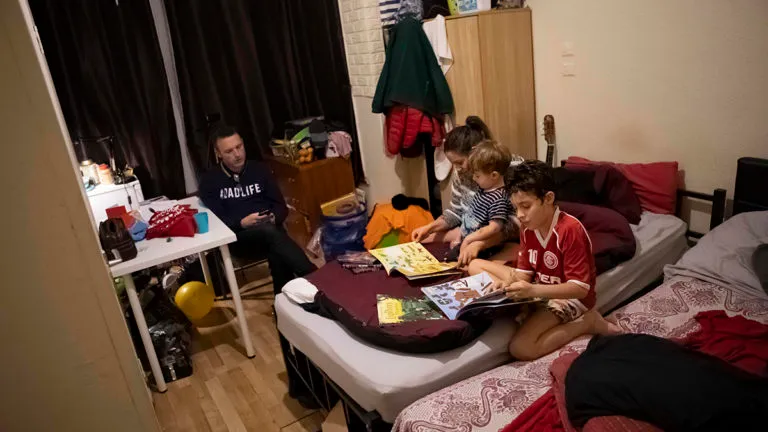Living in lockdown: why home is more important than ever
Published: by Hilary Burkitt

Stay home. It’s the message we’ve heard countless time in this unprecedented period. Our homes have always been the foundation of our lives but suddenly their importance has magnified. The security they provide has never been more real, as we retreat to their sanctuary to stay safe from the pandemic. Home has always been the backdrop for many of the most important aspects of our lives but it is suddenly thrust into new roles – office, school, playground, pub.
And yet, for far too many of us the crisis has laid bare the cracks in these foundations. We do not all have a home that provides sanctuary or that enables our lives to lived out within its walls without extreme impacts on our wellbeing. What we need from our homes is more important than it has ever been – how well do we understand what these needs are?
A Living Home
Four years ago, Shelter undertook a ground-breaking study into the meaning of home, defining what the public believes we should all be able to expect from our home to secure our wellbeing. Through the views of the public, we defined a ‘Living Home Standard’ (LHS), identifying five dimensions:
- Neighbourhood
- Affordability
- Space
- Stability
- Decent conditions
How much can these definitions tell us about what is important to us today, as we live through lockdown?
Shifting priorities
Revisiting what a ‘Living Home’ means today, the neighbourhood dimension is perhaps the most profoundly impacted by the experience of lockdown. Attributes that the public believed were important – such as living near a school or within a reasonable commuting from work are, in this moment, irrelevant to many of us. But other aspects of neighbourhood have come to fore.
The Living Home Standard recognised the importance of having local support networks, and although these have been reshaped in the current crisis, their importance is perhaps clearer than ever. As one participant in the LHS put it is about ‘having a sense that people look out for one another’.
Stability and security
Although the response to the pandemic has spurred new connections to be forged in many neighbourhoods, established bonds within communities provide a basis in which these can flourish. The LHS recognised the importance of being able to ‘put down roots’ and that without the security of a long-term home, people are less able to build links to the local community.
The lockdown has underscored the critical importance of an essential attribute of the LHS: that a household has enough control over how long they can stay in the home. The precarious situation of many renters has been revealed by the crisis, and at Shelter we have heard from many who have feared they have almost no protection from losing their home.
Emergency action by the government to protect tenants from eviction was essential, but longer-term the case for better security for millions of renters has never been stronger.
An affordable home
Security goes hand-in-hand with affordability, and when we developed the Living Home Standard the public recognised it was essential that we can all afford our homes without having to cut back on basics like food or heating, and without worrying we will be able unable to afford to meet future housing costs.
With our latest research showing that 1.7 million renters expect to lose their jobs over the next three months, it’s increasingly vital we have a secure safety net that means losing your job doesn’t mean losing your home.
Space to live
When we developed the LHS, the discussions about space were some of the most animated: while there were sometimes lively debates about exactly how much space we needed and how it might be divided up, the public converged on essential principles about having space in the home to be together, and space to be apart. Under lockdown our living space is under unprecedented amounts of pressure. The LHS debates recognised how important space in our homes is to our mental health and wellbeing, something which is now an acute concern, particularly for families trapped in overcrowded homes.
Our discussions in 2016 could however never have foreseen current needs such as the ability to self-isolate. For some, including families in one-room temporary accommodation, the current situation is nothing short of a public health emergency.
In developing the LHS, many people also highlighted the importance of outdoor space to physical and mental wellbeing – something that has been magnified under lockdown. Recognising that millions of people, including families, have no access to outdoor space of their own has underscored the importance of keeping parks open during lockdown.
Decent conditions
Living in decent, safe conditions is always vital, and the public recognised that we shouldn’t have to compromise on these essentials, such as living without hazards, pests or damp and mould problems. This is even more true now, with the health risks posed by unsafe conditions ever more acute when we are spending so much time in our homes.
The cracks in the foundations
The Living Home Standard clearly set out what we should be able to expect from home that provides a good foundation for our lives. Sadly for far too many of us these foundations are weak. When we developed the Living Home Standard we discovered how widespread this weakness was – over two in five of us did not have everything we needed from our home in order to meet the standard.
But living through lockdown has revealed how deep the cracks run, and a housing emergency that desperately needs fixing. The security of a stable, safe, affordable home has never been needed so much.